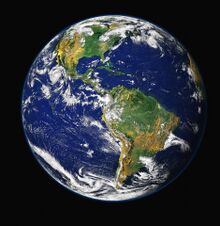Earth
| Earth | |
|---|---|
 | |
| Type | Planet |
| Universe | Universe-A |
| Status | Active |
| Appearances | |
| All | |
Earth is a diverse and vibrant planet located in the Milky Way galaxy, uniquely distinguished by its dynamic landscapes, varied ecosystems, and complex civilizations. Known as the only planet within its solar system that supports intelligent life, Earth hosts a wide range of species, cultures, and advanced societies that have shaped its rich history. With an evolving climate, a delicate balance of natural resources, and ongoing scientific advancements, Earth has become a focal point in the cosmos for its development of technology, governance, and interstellar relations. This planet has produced notable individuals, events, and innovations that continue to impact the larger universe, drawing attention from beings and civilizations across the universe and multiple dimensions.
Overview
Earth is the third planet from the Sun and the densest in the Solar System, known for its unique capability to sustain life due to its water-rich surface, diverse climates, and protective atmosphere. Covering approximately 71% of its surface in oceans and the remainder in landmasses, Earth is home to vast ecosystems and a rich biodiversity. The planet's human population has developed a wide array of cultures, languages, and societies, building civilizations that have shaped Earth’s political, economic, and environmental landscapes.
Throughout its history, Earth has faced transformative periods marked by natural and human events, from ice ages and volcanic eruptions to industrial revolutions and world conflicts. It is a center of innovation, with humanity advancing rapidly in science, medicine, and technology, reaching the point of space exploration and interstellar awareness. Earth's ongoing journey reflects its adaptability and resilience, making it a singular example of life’s persistence and evolution amid the broader cosmos.
History
Formation
The Solar System, including Earth, formed around 4.6 billion years ago. This process began in a vast cloud of gas and dust, known as a molecular cloud, which likely resulted from earlier stellar explosions (supernovae) that enriched the region with elements. Over time, gravity caused the cloud to collapse, forming a rotating disk of material with a dense central region. As this central region continued to compress under gravity, it ignited nuclear fusion reactions, creating our Sun.
The remaining matter in the disk began to coalesce due to gravity and collisions, forming clumps that eventually grew into planets, moons, asteroids, and other bodies. Earth itself formed roughly 4.54 billion years ago from the accretion of dust and rocky material orbiting the young Sun. During this early period, Earth was subject to intense volcanic activity, frequent collisions, and bombardments from other celestial bodies. One significant impact event is believed to have led to the formation of the Moon.
As Earth cooled over millions of years, a crust formed on its surface, volcanic outgassing created a primitive atmosphere, and water vapor condensed, forming the first oceans. This marked the beginning of Earth’s transition to a stable environment capable of supporting life, setting the stage for the planet's complex geological and biological evolution.
Rise of Humanity
Madame Wilhelmina
To be added.
Doctor Hex
To be added.
World War I
World War I, lasting from 1914 to 1918, began with the assassination of Archduke Francis Ferdinand of Austria on June 28, 1914, sparking Austria-Hungary's declaration of war on Serbia. This conflict quickly escalated as major European powers aligned, with Germany declaring war on Russia and France and invading Luxembourg and Belgium. By August, Britain joined against Germany, marking the expansion of hostilities across Europe. Key battles ensued, including the First Battle of Ypres and Battle of Mons in 1914. In subsequent years, notable battles like Verdun, Jutland, and the Somme demonstrated the scale and devastation of trench warfare. U.S. involvement in 1917 marked a turning point, as the Allies launched final offensives in 1918, culminating in an armistice signed by Germany on November 11, 1918.
The Ghost
To be added.
Pre-World War II
The prelude to World War II (1933–1939) saw Adolf Hitler’s rise to power in 1933 and Japan’s aggressive expansion in Asia. Germany, under Hitler, initiated territorial annexations, including Austria (Anschluss) and Czechoslovakia, while Britain and France engaged in appeasement efforts, notably the Treaty of Munich. However, tensions reached a breaking point in September 1939 when Hitler invaded Poland, leading Britain and France to declare war. This began the "Phoney War" phase, which ended in 1940 as Germany invaded several European nations and launched the Blitzkrieg against France and the Low Countries. Key events included the Dunkirk evacuation and the Battle of Britain.
World War II
World War II (1939–1945) was marked by pivotal battles across Europe, Africa, and the Pacific. Major events included Germany’s invasion of Russia (Operation Barbarossa), Japan’s attack on Pearl Harbor, and the Allied victories at Midway, El Alamein, and Stalingrad. The 1944 D-Day invasion in Normandy opened a Western Front, leading to the liberation of Paris and, by 1945, the fall of Berlin. In the Pacific, atomic bombs dropped on Hiroshima and Nagasaki in August 1945 forced Japan's surrender, officially ending the war on September 2, 1945.
Purple Bolt
Jonathan Kayne was born on September 19, 2002, to Emily and Peter Kayne. At age five, an experiment by his father resulted in Jonathan being struck by lightning, and after recovery, he began showing superhuman speed abilities in 2020. Following discovery and self-training, Jonathan adopted the superhero identity "The Bolt."
Notable locations
|
Notable people
See also
| Locations | |
|---|---|
| Earth | Asgard (alternate dimension) | |
